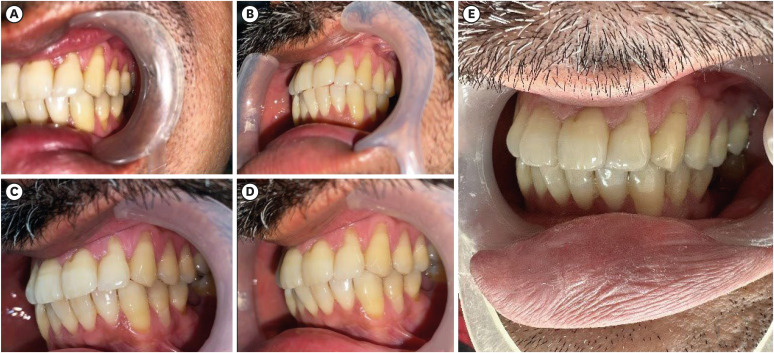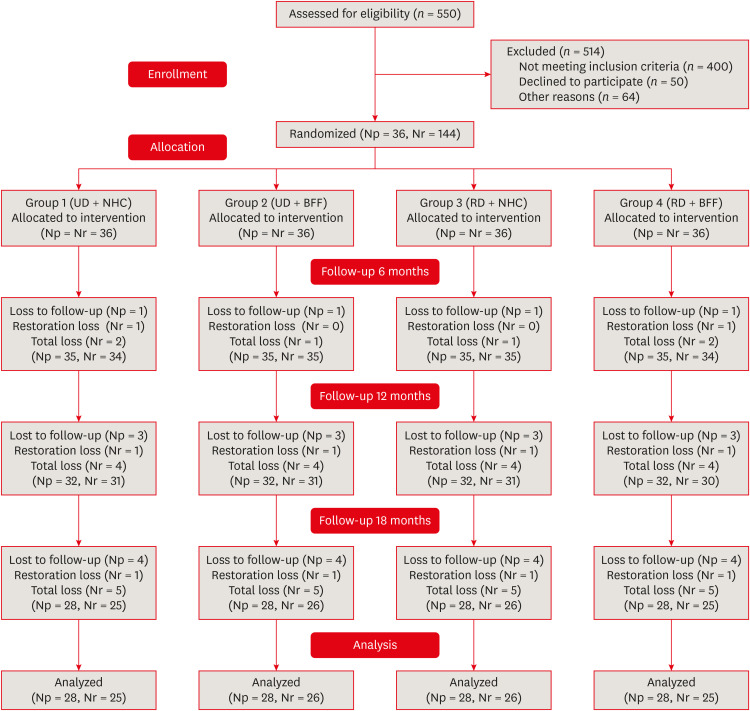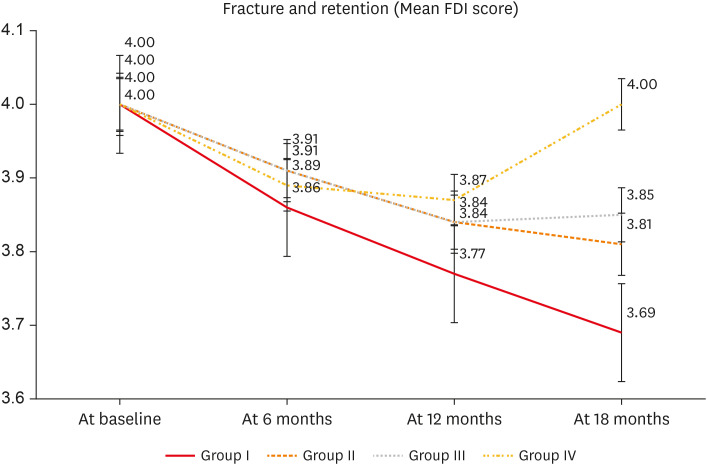Restor Dent Endod.
2023 Nov;48(4):e35. 10.5395/rde.2023.48.e35.
Effect of dentin roughening and type of composite material on the restoration of non-carious cervical lesions: an in vivo study with 18 months of follow-up
- Affiliations
-
- 1Department of Conservative Dentistry and Endodontics, JCD Dental College, Sirsa, India
- KMID: 2548756
- DOI: http://doi.org/10.5395/rde.2023.48.e35
Abstract
Objectives
The purpose of this study was to evaluate the impact of dentin roughening and the type of composite resin used (either bulk-fill flowable or nanohybrid) on the restoration of non-carious cervical lesions (NCCLs) with an 18-month follow-up period.
Materials and Methods
This prospective split-mouth study included 36 patients, each with a minimum of 4 NCCLs. For each patient, 4 types of restorations were performed: unroughened dentin with nanohybrid composite, unroughened dentin with bulk-fill flowable composite, roughened dentin with nanohybrid composite, and roughened dentin with bulk-fill flowable composite. A universal bonding agent (Tetric N Bond Universal) was applied in self-etch mode for all groups. The restorations were subsequently evaluated at 6, 12, and 18 months in accordance with the criteria set by the FDI World Dental Federation. Inferential statistics were computed using the Friedman test, with the level of statistical significance established at 0.05.
Results
The 4 groups exhibited no significant differences in relation to fracture and retention, marginal staining, marginal adaptation, postoperative hypersensitivity, or the recurrence of caries at any follow-up point.
Conclusions
Within the limitations of the present study, over an 18-month follow-up period, no significant difference was present in the clinical performance of bulk-fill flowable and nanohybrid composite restorations of non-carious cervical lesions. This held true regardless of whether dentin roughening was performed.
Figure
Reference
-
1. Medeiros TL, Mutran SC, Espinosa DG, do Carmo Freitas Faial K, Pinheiro HH, D’Almeida Couto RS. Prevalence and risk indicators of non-carious cervical lesions in male footballers. BMC Oral Health. 2020; 20:215. PMID: 32727438.
Article2. Teixeira DN, Thomas RZ, Soares PV, Cune MS, Gresnigt MM, Slot DE. Prevalence of noncarious cervical lesions among adults: a systematic review. J Dent. 2020; 95:103285. PMID: 32006668.
Article3. Heintze SD, Ruffieux C, Rousson V. Clinical performance of cervical restorations--a meta-analysis. Dent Mater. 2010; 26:993–1000. PMID: 20638116.
Article4. Szesz A, Parreiras S, Martini E, Reis A, Loguercio A. Effect of flowable composites on the clinical performance of non-carious cervical lesions: a systematic review and meta-analysis. J Dent. 2017; 65:11–21. PMID: 28729119.
Article5. Karan K, Yao X, Xu C, Wang Y. Chemical profile of the dentin substrate in non-carious cervical lesions. Dent Mater. 2009; 25:1205–1212. PMID: 19464050.
Article6. Loguercio AD, Luque-Martinez IV, Fuentes S, Reis A, Muñoz MA. Effect of dentin roughness on the adhesive performance in non-carious cervical lesions: a double-blind randomized clinical trial. J Dent. 2018; 69:60–69. PMID: 28962842.
Article7. van Dijken JW. Clinical evaluation of three adhesive systems in class V non-carious lesions. Dent Mater. 2000; 16:285–291. PMID: 10831784.
Article8. van Dijken JW. Retention of a resin-modified glass ionomer adhesive in non-carious cervical lesions. A 6-year follow-up. J Dent. 2005; 33:541–547. PMID: 16005793.
Article9. Lührs AK, Jacker-Guhr S, Günay H, Herrmann P. Composite restorations placed in non-carious cervical lesions-which cavity preparation is clinically reliable? Clin Exp Dent Res. 2020; 6:558–567. PMID: 32924312.
Article10. Rocha AC, Da Rosa W, Cocco AR, Da Silva AF, Piva E, Lund RG. Influence of surface treatment on composite adhesion in non-carious cervical lesions: systematic review and meta-analysis. Oper Dent. 2018; 43:508–519. PMID: 29570026.
Article11. Mahn E, Rousson V, Heintze S. Meta-analysis of the influence of bonding parameters on the clinical outcome of tooth-colored cervical restorations. J Adhes Dent. 2015; 17:391–403. PMID: 26525003.12. van Dijken JW. A prospective 8-year evaluation of a mild two-step self-etching adhesive and a heavily filled two-step etch-and-rinse system in non-carious cervical lesions. Dent Mater. 2010; 26:940–946. PMID: 20646753.
Article13. Loguercio AD, Raffo J, Bassani F, Balestrini H, Santo D, do Amaral RC, et al. 24-Month clinical evaluation in non-carious cervical lesions of a two-step etch-and-rinse adhesive applied using a rubbing motion. Clin Oral Investig. 2011; 15:589–596.
Article14. Luque-Martinez I, Muñoz MA, Mena-Serrano A, Hass V, Reis A, Loguercio AD. Effect of EDTA conditioning on cervical restorations bonded with a self-etch adhesive: a randomized double-blind clinical trial. J Dent. 2015; 43:1175–1183. PMID: 25963586.
Article15. Zander-Grande C, Amaral RC, Loguercio AD, Barroso LP, Reis A. Clinical performance of one-step self-etch adhesives applied actively in cervical lesions: 24-month clinical trial. Oper Dent. 2014; 39:228–238. PMID: 23937405.
Article16. Luque-Martinez IV, Mena-Serrano A, Muñoz MA, Hass V, Reis A, Loguercio AD. Effect of bur roughness on bond to sclerotic dentin with self-etch adhesive systems. Oper Dent. 2013; 38:39–47. PMID: 22770432.
Article17. Kemp-Scholte CM, Davidson CL. Complete marginal seal of class V resin composite restorations effected by increased flexibility. J Dent Res. 1990; 69:1240–1243. PMID: 2141338.
Article18. Ichim IP, Schmidlin PR, Li Q, Kieser JA, Swain MV. Restoration of non-carious cervical lesions Part II. Restorative material selection to minimise fracture. Dent Mater. 2007; 23:1562–1569. PMID: 17391747.
Article19. Vildósola P, Nakouzi J, Rodriguez S, Reyes A, Reyes J, Conejeros C. Six-month follow-up of two Bulk-fill composites in non-carious cervical lesions: double blind randomized clinical trial. J Oral Res. 2019; 8:210–219.
Article20. Canali GD, Ignácio SA, Rached RN, Souza EM. One-year clinical evaluation of bulk-fill flowable vs. regular nanofilled composite in non-carious cervical lesions. Clin Oral Investig. 2019; 23:889–897.
Article21. Correia A, Jurema A, Andrade MR, Borges A, Bresciani E, Caneppele T. Clinical evaluation of noncarious cervical lesions of different extensions restored with bulk-fill or conventional resin composite: preliminary results of a randomized clinical trial. Oper Dent. 2020; 45:E11–E20. PMID: 31794342.
Article22. Aw TC, Lepe X, Johnson GH, Mancl L. Characteristics of noncarious cervical lesions: a clinical investigation. J Am Dent Assoc. 2002; 133:725–733. PMID: 12083648.23. Swift EJ Jr, Perdigão J, Heymann HO, Wilder AD Jr, Bayne SC, May KN Jr, et al. Eighteen-month clinical evaluation of a filled and unfilled dentin adhesive. J Dent. 2001; 29:1–6. PMID: 11137632.
Article24. Hickel R, Peschke A, Tyas M, Mjör I, Bayne S, Peters M, et al. FDI World Dental Federation: clinical criteria for the evaluation of direct and indirect restorations-update and clinical examples. Clin Oral Investig. 2010; 14:349–366.
Article25. Peumans M, De Munck J, Van Landuyt KL, Kanumilli P, Yoshida Y, Inoue S, et al. Restoring cervical lesions with flexible composites. Dent Mater. 2007; 23:749–754. PMID: 16949661.
Article26. van Dijken JW, Pallesen U. A 7-year randomized prospective study of a one-step self-etching adhesive in non-carious cervical lesions. The effect of curing modes and restorative material. J Dent. 2012; 40:1060–1067. PMID: 22955004.
Article27. Kubo S, Yokota H, Yokota H, Hayashi Y. Three-year clinical evaluation of a flowable and a hybrid resin composite in non-carious cervical lesions. J Dent. 2010; 38:191–200. PMID: 19840829.
Article28. Femiano F, Femiano R, Femiano L, Festa V, Rullo R, Perillo L. Noncarious cervical lesions: correlation between abfraction and wear facets in permanent dentition. Open J Stomatol. 2015; 5:152–157.
Article29. Takehara J, Takano T, Akhter R, Morita M. Correlations of noncarious cervical lesions and occlusal factors determined by using pressure-detecting sheet. J Dent. 2008; 36:774–779. PMID: 18597913.
Article30. Kwong SM, Cheung GS, Kei LH, Itthagarun A, Smales RJ, Tay FR, et al. Micro-tensile bond strengths to sclerotic dentin using a self-etching and a total-etching technique. Dent Mater. 2002; 18:359–369. PMID: 12175574.
Article31. Tay FR, Pashley DH. Resin bonding to cervical sclerotic dentin: a review. J Dent. 2004; 32:173–196. PMID: 15001284.
Article32. Tay FR, Kwong SM, Itthagarun A, King NM, Yip HK, Moulding KM, et al. Bonding of a self-etching primer to non-carious cervical sclerotic dentin: interfacial ultrastructure and microtensile bond strength evaluation. J Adhes Dent. 2000; 2:9–28. PMID: 11317411.33. Van Meerbeek B, Braem M, Lambrechts P, Vanherle G. Morphological characterization of the interface between resin and sclerotic dentine. J Dent. 1994; 22:141–146. PMID: 8027456.
Article34. Ritter AV, Heymann HO, Swift EJ Jr, Sturdevant JR, Wilder AD Jr. Clinical evaluation of an all-in-one adhesive in non-carious cervical lesions with different degrees of dentin sclerosis. Oper Dent. 2008; 33:370–378. PMID: 18666493.
Article35. Ruschel VC, Shibata S, Stolf SC, Chung Y, Baratieri LN, Heymann HO, et al. Eighteen-month clinical study of universal adhesives in noncarious cervical lesions. Oper Dent. 2018; 43:241–249. PMID: 29676975.
Article36. Zanatta RF, Silva TM, Esper M, Bresciani E, Gonçalves S, Caneppele T. Bonding performance of simplified adhesive systems in non carious cervical lesions at 2-year follow-up: a double-blind randomized clinical trial. Oper Dent. 2019; 44:476–487. PMID: 30702405.
Article37. Cruz J, Silva AL, Eira R, Coito C, Sousa BR, Lopes MM, et al. 24-month clinical performance of a universal adhesive on non-carious cervical lesions: self-etch and etch-and-rinse techniques. J Adhes Dent. 2021; 23:379–387. PMID: 34549921.38. Rouse MA, May JT, Platt JA, Cook NB, Capin OR, Adams BN, et al. Clinical evaluation of a universal adhesive in non-carious cervical lesions. J Esthet Restor Dent. 2020; 32:691–698. PMID: 32757232.
Article
- Full Text Links
- Actions
-
Cited
- CITED
-
- Close
- Share
- Similar articles
-
- Effective Management of Multiple Non-carious Cervical Lesions with Gingival Recession and Dentin Hypersensitivity: Two Cases Report of Combined Restorative and Periodontal Approach
- A 48-month clinical performance of hybrid ceramic fragment restorations manufactured in CAD/CAM in noncarious cervical lesions: case report
- Shear bond strength of a self-adhesive resin cement to resin-coated dentin
- The influence of combining composite resins with different elastic modulus on the stress distribution of Class V restoration: a three-dimensional finite element study
- The effects of dentin bonding agent thickness on stress distribution of composite-tooth interface : Finite element method




